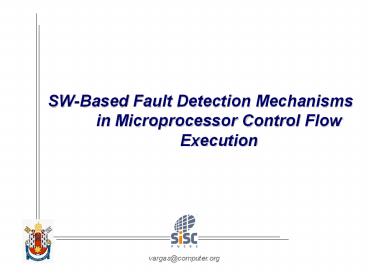SW-Based Fault Detection Mechanisms in Microprocessor Control Flow Execution - PowerPoint PPT Presentation
1 / 9
Title:
SW-Based Fault Detection Mechanisms in Microprocessor Control Flow Execution
Description:
Basically, the approach consists of six steps: 1) Divide the program into basic blocks. ... ( b) E: set of edges denoting possible CF between basic blocks. ... – PowerPoint PPT presentation
Number of Views:37
Avg rating:3.0/5.0
Title: SW-Based Fault Detection Mechanisms in Microprocessor Control Flow Execution
1
SW-Based Fault Detection Mechanismsin
Microprocessor Control Flow Execution
2
- Faults Affecting Microprocessor Control-Flow
Execution - 1) Control-Flow Checking by Software Signatures
(CFCSS) McCluskey et al.
Principle Modification of a Basic Block
3
- Faults Affecting Microprocessor Control-Flow
Execution - 1) Control-Flow Checking by Software Signatures
(CFCSS) McCluskey et al.
Basically, the approach consists of six
steps 1) Divide the program into basic
blocks. A basic block is a minimal set of ordered
instructions in which its execution begins from
the first instruction and terminates at the last
instruction. There is no branching instruction in
a basic block except possibly for the last one. A
basic block terminates at either an instruction
branching to another basic block or an
instruction receiving transfer of control flow
(CF) from two or more places in the program.
Notations (a) V vi i 1, 2,, n set of
vertices denoting basic blocks. (b) E set of
edges denoting possible CF between basic
blocks. 2) Construct a graph for the program
according to the instructions flow (each node
represents a basic block). Note that a program
can be represented by a program-graph, P, where
bri,j are not necessarily explicit branch
instructions they also represent fall-through
execution paths, jumps, subroutine calls, and
returns. Fig. 2.5 is an example. Notation P
Program Graph V, E. 3) Arbitrarily assign
a signature for each node (compilation
time). 4) Compute the signature difference
between the source and the destiny
blocks. 5) Compute the new signature for
each node (execution time). 6) Compare both
signatures.
4
- Faults Affecting Microprocessor Control-Flow
Execution - 1) Control-Flow Checking by Software Signatures
(CFCSS) McCluskey et al.
5
- Faults Affecting Microprocessor Control-Flow
Execution - 1) Control-Flow Checking by Software Signatures
(CFCSS) McCluskey et al.
Detection of an illegal branch a numerical
example
6
- Faults Affecting Microprocessor Control-Flow
Execution - 1) Control-Flow Checking by Software Signatures
(CFCSS) McCluskey et al.
Node v1 and node v3 have the same signatures
Branch Fan-in Nodes
7
- Faults Affecting Microprocessor Control-Flow
Execution - 1) Control-Flow Checking by Software Signatures
(CFCSS) McCluskey et al.
Node v1 and node v3 have different signatures
Adjusting Signature D
8
- Faults Affecting Microprocessor Control-Flow
Execution - 1) Control-Flow Checking by Software Signatures
(CFCSS) McCluskey et al.
Node v1 and node v3 have different signatures
Adjusting Signature D
9
- Faults Affecting Microprocessor Control-Flow
Execution - 1) Error Capturing Instructions (ECI) Miremadi
et al.
- Insertion of trap instructions in the program
area, in the data area, and in the unused area of
the memory. - The ECIs are inserted in the main memory
locations that are not used by the CPU during
normal execution. Thus, the execution of an ECI
is a indication that a control flow error has
occurred. - The task of an ECI is to initiate a recovery
process.






























